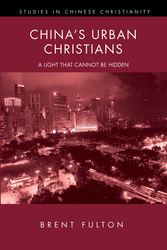 China’s Urban Christians: A Light that Cannot Be Hidden, Brent Fulton, Pickwick Publications, Eugene, Oregon, 2015, 156 pp. ISBN 13:978-1-62564-719-1; paperback, $20.98 at Amazon.com and $9.99 Kindle edition.
China’s Urban Christians: A Light that Cannot Be Hidden, Brent Fulton, Pickwick Publications, Eugene, Oregon, 2015, 156 pp. ISBN 13:978-1-62564-719-1; paperback, $20.98 at Amazon.com and $9.99 Kindle edition.
Reviewed by Li Jin
Since the market reform in 1978, Chinese society has undergone an unprecedented structural change known as urbanization. The urban population is now sixty percent of the total as compared to nineteen percent in 1980. More than 500 million rural residents have moved into China’s urban centers. Studies on Chinese Christianity have yet to keep up with the implications of this change. Chinese churches sometimes still enjoy the stereotypical description of being rural and uneducated, persecuted but revived. With urbanization and social change, China’s churches have acquired a different landscape with diverse structures and expressions of faith. This requires scholars, as well as Chinese Christians, to adopt a different lens in examining the growth of Christianity in the midst of various social trends. For this reason, China’s Urban Christians: A Light that Cannot Be Hidden, ChinaSource president Brent Fulton’s recent book, is a timely update to our understanding of Chinese Christianity. As a long-time China observer, Dr. Fulton knows well how significant urbanization, with its offers of technology, population concentration, wealth, and commercial boom, is going to impact Chinese Christianity. Urbanization inevitably provides both opportunities and challenges to Christian groups in China.
As Fulton points out in this book, in this phase of frenzied change, China’s urban churches make up a major body of Chinese Christianity with unusual diversity. Most constituents have received higher education and entered middle-class professionalism (10). With such demographic changes, churches are also going through a period of professionalization. Today, the unregistered churches in China look very different from their rural counterparts thirty years ago. More and more clergy are obtaining theological education and pastoring churches with a professional spirit. Unlike their predecessors, these leaders are no longer “the silent majority.” As Fulton writes, “…they are seen as professionals fulfilling a rather unique, but nonetheless legitimate, role in society. Their public presence vis-à-vis government, media, academia, and other social domains gives the church a voice in the society which it previously did not have” (36). These young pioneers of the faith know how to use new media to express their faith and to localize their theological concerns in Chinese soil. Fulton pays attention to how Christians actively engage in cyber discussions as one important dimension of their urban social life despite tightening Internet censorship. Meanwhile, Fulton also observes the weaknesses of these professing urban professionals: “Professionalism also widens the gap between clergy and laity, replacing the church’s former collegiality with a new class system that differentiates between those with formal training and those without” (37).
Urban Christians in China also face new spiritual challenges. In chapter four titled, “A Shifting Battleground,” Fulton points out materialism, secularism, and pervasive moral decline in the urban space. Piety is no longer an assumed characteristic of the Chinese church; rather, it is struggling with the same worldly tides as its Western counterpart. Influences from economic market activities and post-modern thought are making their way into urban churches turning many into groups carrying consumeristic marks. Fulton quotes a statement from a young urban pastor in an interview that, “The church is a social club (julebu). The pastor depends on exciting programs to keep people entertained . . . Believers expect God to bless them. They wouldn’t know what to do if they encountered difficulty” (55).
Besides consumerism, Fulton also examines the marriages and families of these Chinese Christians. This young generation of urban Christians is swimming against the tides of one-child policy and communist ethics that intervene in family life. These are brand-new problems for these first-generation, urban Christians. Fulton insightfully captures a catalyst for social transition, that is, the growth of an ethical system that differs from traditional values in China.
Institutional changes are taking place in urban China as well with many Christians withdrawing their children from public schools and starting Christian schools and charity organizations. Churches develop various social service programs with creativity when reaching out to their urban neighbors. Trends that are countering consumerism and promoting social service are internal drivers for the improvement and transition of Chinese society. Fulton hopes that, “Doing so would gain the church legitimacy within society as Christians are seen caring not only for their own needs but also for the needs of their community” (66). This hope is partially realized in the social realm, although not to the liking of political authorities.
Any study of Chinese society has to face the paradox of its reality. On the one hand, registered churches are having the crosses on their churches removed in a few provinces. On the other hand, we have to admit that churches in China are enjoying a certain degree of freedom. Policies may affect churches differently even in the same location. Take Beijing for example. Shouwang Church and Zion Church, both unregistered, are treated differently by the local authority. This poses difficulties to China researchers because they have to present fairly both the particularity and universality of Chinese Christianity. Previous studies on Wenzhou Christianity and commercial ethics, for instance, have to readjust their understanding after the recent “cross removal” campaigns. Researchers always need to face criticisms against their methodology in using qualitative, non-random interviews. Representative surveys often have the trade-off of simplifying the cultural and local nuances. Given the research strategies we have now, this book is a commendable effort to depict and analyze the real landscape of Chinese Christianity that is becoming increasingly urban. The presence of Christians in China’s urban centers needs to be considered by sociologists and historians who desire to understand China’s social transition within the twenty-first century. This public phase of Chinese Christianity is relevant to the growth of China’s civil society and public life. Connecting the good earth of China with a heavenly kingdom, their stories record the changing China, and their voices need to be heard.
Translation by Mary Ma

LI Jin
LI Jin is a PhD student at Calvin Theological Seminary. Prior to seminary he was a PhD candidate in economic history at a Shanghai university. He writes on Christian thought for both public and Christian media outlets in mainland China and Hong Kong. LI Jin and wife Mary Li Ma have coauthored articles, book …View Full Bio